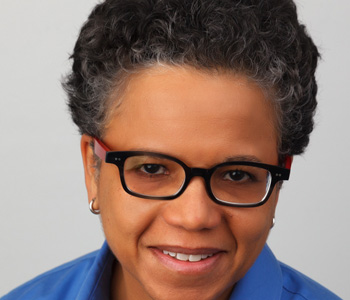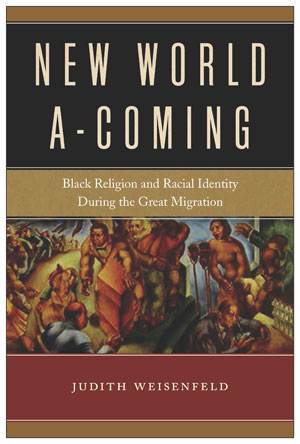
New World A-Coming examines a set of religious movements founded in the early twentieth-century urban north whose members refused the racial category of Negro and rejected Christianity in favor of other identities. In the Moorish Science Temple and the Nation of Islam, members believed their true identities to be Asiatic Muslim, while members of Congregation Beth B’nai Abraham and the Commandment Keepers embraced Ethiopian Hebrew identity. In the Peace Mission movement, Father Divine’s followers believed him to be God and took up his call to reject race altogether. I argue that what drew people to these movements was not only that they offered diverse religious options, but that in linking religious and racial identity, they provided new ways of thinking about black history and peoplehood.
These religio-racial movements, as I call them, emerged in the context of the large-scale migration of African Americans from the South to the cities of the North and the immigration of Blacks from the Caribbean to the U.S. The cultural creativity in black literature, visual arts, and music of the Great Migration era is well known, as is the political activism in movements like Jamaican immigrant Marcus Garvey’s Universal Negro Improvement Association. Religious creativity also marked the period, and charismatic leaders, some claiming status as prophets or divinities, captured the imaginations of black urbanites. These leaders’ preaching and teaching motivated many to transform how they understood their individual identities, collective histories, and imagined futures.
In addition to examining the religio-racial theologies and histories the leaders put forth, the book explores the question of how one transforms one’s identity. How did a black migrant from the South or an immigrant from the Caribbean detach from the identity of Negro once they came to believe that it was a false category produced in slavery and imposed on them? Through what means did they become what they believed they truly were, be it Asiatic Muslim, Ethiopian Hebrew, or raceless child of God? What were the stakes for them in doing so in a highly racialized society in which people of African descent had long invested in racial solidarity under the banner Christianity to oppose racism and oppression?
In order to understand this process of transformation, I examine embodied practices members used to remake themselves, such as adopting new names, styles of dress, dietary practices, and approaches to health and healing they believed were appropriate to and required by their religio-racial identity. I also consider how participation in a religo-racial movement transformed members’ understandings of family, community, politics, space and place, and relationships to the world beyond the movement. The book explores the distinctive elements of each religio-racial movement while also offering a sense of the common practices and strategies members developed to become what they believed God had made them. For members, these were not practices that led to conversion, then, but reversion to a divinely ordained self.
This topic provided the perfect opportunity for me to continue exploring the intersections of religion and race in American history. In earlier work I examined the role early sound film played in constructing and disseminating ideas about African American religion and race more broadly. In looking at Hollywood films I found that representations of black religious practices, leaders, institutions, and theologies often aided arguments about the limited civic, political, emotional, and moral capacity of African Americans. In other instances, black filmmakers used the medium to challenge Hollywood images either directly or through representations that offered a more complex picture of black religious life. My work engaged the movies as an early twentieth-century arena for conversations and debates about blackness that took place through representations of religion.
With the religio-racial movements, we can see another locus for discussions within black communities about the nature and meaning of blackness. Participants in the movements insisted on the significance of religion to any answer to the question of who we are as black individuals and black people. And, in contrast to a good deal of the scholarship on these groups, the racial component of the identities members embraced – of Asiatic Muslim, Ethiopian Hebrew, or raceless child of God – were profoundly important to them and also required for understanding the nature and meaning of blackness. It is not sufficient to think about these groups as primarily oriented toward Islam or Judaism, for example, because, for members, race and religion were connected and dependent on one another.
I was also interested in moving away from the scholarly tendency to focus on the founders and leaders of the movements and on the theologies they taught. This focus is entirely understandable given how fascinating figures like Father Divine, who claimed he was God, and Noble Drew Ali, the founder of the Moorish Science Temple, who declared himself a divinely appointed prophet, were. Their charisma was certainly a factor in what drew people to the movements, but charisma alone does not explain why people were willing to change their lives often in dramatic ways. In fact, members of the movements sometimes broke with family members, changed their names and habits of living, and came into conflict with the government over insistence on being recognized in their correct religio-racial identities.
Turning to explore the experiences of the first generations of members of the movements, to the extent that the sources allowed, enabled me to think more about the sources of the appeal of the different groups beyond the charismatic leader. We can see how, through participation in the movements, the members helped to shape both theology and practice. It becomes difficult when one looks at the degree and depth of commitment to view them as dupes of unscrupulous charismatic leaders, as many contemporary critics argued they were.
In addition, as dramatic and countercultural as the leaders and members were in their practices – wearing fezzes or turbans, taking spiritual names, transforming their diets, or rejecting their families for communal celibacy, for example – they were very much in line with broader African American culture in taking up questions about racial identity and the nature of peoplehood for people of African descent. I was interested in showing how they contributed to these broader discussions.
I begin the book with the stories of a number of men who were members of the Moorish Science Temple, the Commandment Keepers Ethiopian Hebrew Congregation, and Father Divine’s Peace Mission registering for the draft in April 1942. Each refused to be classified as Negro and asked the draft registrar to substitute what they believed was the correct religio-racial designator. These stories are a great entry point for the project because they highlight the high stakes of religio-racial assertions for members of these groups. At this significant moment of military registration, where issues of race, racism, national belonging and exclusion were evident, these men insisted that they be represented as they believed God had created them rather than how the government chose to classify them.
The draft cards themselves showcase the kinds of sources on which I drew to tell the story of average members of the religio-racial movements. While sermons, scriptures, correspondence, and newspaper articles were important sources, I also turned to records like birth and death certificates, marriage licenses, wills, FBI surveillance files, state and federal censuses to track average members. These kinds of documents, that capture moments in everyday life and in public actions from birth to death, reveal the extent and power of members’ embrace of religio-racial identities.
I hope that readers will come away with tools to think about the complicated ways that race and religion have interacted with one another in American history. Ideas about race, racial categories, and racial identities have changed over time, and religion has contributed to how Americans have thought about race, enacted policies that maintain racial hierarchy, and move through the world as racialized beings.
The specific case of the religio-racial movements highlights the complexity of conceptions of race among early twentieth-century African Americans and black immigrants from the Caribbean. Recent discussions of the possibility of a post-racial America assume that race is fixed and that people inhabit obvious categories. The history of these groups shows a more complicated story. Their perspectives may not have become the dominant ones, but their challenge to conventional understandings of racial identity and the role of religion in black life took place in a larger context of discussion about the meaning of blackness.
Exploring the histories, beliefs, and practices of the religio-racial movements also encourages us to recognize diversity within African American religious life. These groups have long been characterized as cults in a way that marginalizes them as illegitimate in relation to religious orientations considered acceptable in the American context. As a label, cult perhaps says more about the assumptions of the person deploying it than about the theological and social characteristics of any particular movement. Describing the groups in a way that I think captures what motivated participants avoids privileging certain religions as authentic and true over against others that are denigrated as invented and false. Rather than labeling the groups cults and attaching assumptions to them, such an approach requires attending to their specific theologies and practices as well as situating them within the broader landscape of American religious life.


Judith Weisenfeld is Agate Brown and George L. Collord Professor of Religion and associated faculty in the Department of African American Studies at Princeton University where she has taught since 2007. In addition to New World A-Coming: Black Religion and Racial Identity during the Great Migration, featured in her Rorotoko interview, she is the author of Hollywood Be Thy Name: African American Religion in American Film, 1929-1949 (California, 2007) and African American Women and Christian Activism: New York’s Black YWCA, 1905-1945 (Harvard University Press, 1997). She is an also editor of the journal Religion and American Culture.